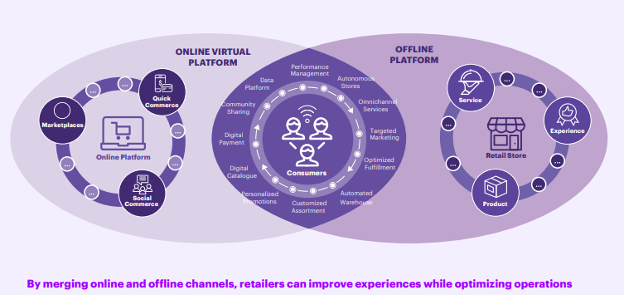Over the past few years, macroeconomic conditions such as higher inflation have led to higher retail volatility — consumers’ purchasing power has dwindled while retailers’ costs have steadily risen. Also, since the pandemic, consumer behavior has skewed heavily toward digital channels. Throw in rapid technological advancements — such as AI-driven customer experiences — and many retailers have begun experimenting with how they can optimize their costs to ensure healthy margins and continued customer spending. To succeed amidst high levels of volatility, retailers are reimagining their real estate strategies using predictive and location analytics.
Retail experience of the future, now
Imagine a retail experience where in-person and digital stores are both highly personalized. A customer experience where shoppers who don’t make an in-store purchase can go online and pick up exactly where they left off, making a purchase from the comfort of anywhere. That’s the idea behind the retail store of tomorrow, one that blends online and offline experiences using the power of data.

Source: “Store of Tomorrow,” Accenture
Accenture, one of Alteryx’s premier partners, utilizes their “Shape of Chain” capability to optimize omnichannel experiences by answering key questions with data, such as “How do I grow my sales in different markets? Are my stores tailored to meet local consumer demand?” and “How do my stores support online sales revenue?” Accenture’s Shape of Chain capability harnesses a suite of analytics solutions, including the Alteryx Platform and visualization tools such as Tableau, to accomplish this feat. The goal is that, by using intelligent models and interactive dashboards, retailers can quickly and effectively predict where they should set up stores and answer vital questions for their retail strategies.
Shape of chain use case: commercial bank in the UK
Here’s an example of how this played out in real life. A large retail and commercial bank needed a fast-paced, data-driven plan for future store estate optimization that fulfilled their ambitious store growth plan that integrated new format propositions into their operating models.
Accenture started by conducting an in-depth study of the bank’s customers, including segmentation of the personal and business customer universe. Next, they deployed a suite of analytics tools (including Alteryx and Tableau) to develop 11 predictive models, spanning personal and business customers and product types, as well as key volume and value metrics.
The evaluation incorporated a plan for existing store venues together with the prioritization of new opportunities. Resulting recommendations and insights fed directly into new format development and operating models. The result? The bank had insights to inform their real estate decisions based on how the different store formats and locations supported and complemented each other.
The Shape of Chain Capability in Action
- Catchment area analysis quantifies the travel times of customers to the store network to understand market capture.
- Customer profiling (using external geodemographic data) pinpoints customers’ distance from the stores.
- Cannibalization analysis measures the impact of opening and closing stores over time.
- Spatial and modeling capabilities analyze internal and external data to provide interactive outputs via a visualization solution.
Driving operational efficiencies with self-service analytics
Retailers that learn to profit from near-real-time insights will inevitably gain operational advantages over competitors. To gain faster insights, retailers must invest in the right analytics and AI tools that bridge the functional gap between analytics teams and business teams — they must empower business users and decision-makers with tools that allow them to explore data without relying on IT or data scientists.
The Alteryx Analytics Cloud Platform is designed to be extremely approachable and easy to use, so anyone can perform cloud-based spatial analysis and go from insights to actions even faster by synthesizing and summarizing critical insights utilizing AI. Users can create custom maps and visualize data through a map-centric user interface to easily identify patterns and trends that may not be immediately apparent in spreadsheet-based data analysis.
By combining the right strategies and investing in the right technology and talent, retailers can significantly reduce the time it takes to create actionable insights, enabling them to make faster and more informed decisions in a rapidly changing marketplace.
Tune in to Alter.Next: Enterprise of the Future now, where Accenture Retail Strategy Manager Luke Gibson shares how Accenture is helping large brands leverage the latest technologies to build the store of the future.